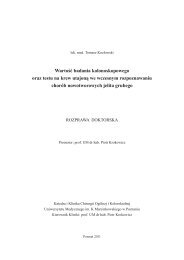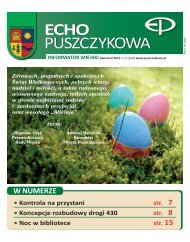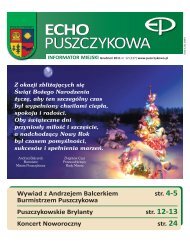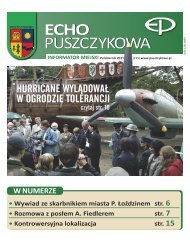MILITARY PHARMACY AND MEDICINE
MILITARY PHARMACY AND MEDICINE
MILITARY PHARMACY AND MEDICINE
You also want an ePaper? Increase the reach of your titles
YUMPU automatically turns print PDFs into web optimized ePapers that Google loves.
© Military Pharmacy and Medicine • 2012 • 4 • 22 – 26be not only due to patient-to-patient transmission,but also to the consumption of food ofpoor microbial quality. The threat may originatemainly from products brought to patientsby visitors [1]. It is common for the visitors tobring drinks in large packagings, both cartonand plastic bottles. Patients, particularly childrenand the elderly, have difficulties usingsuch packagings. This also pertains to patientswho cannot move easily after procedures theyunderwent. With water consumption recommendationssuggesting that a single servingshould not exceed ca. 100 mL (in adults), depletionof a 1.5 L, or sometimes even a 2 L takes asignificant amount of time [4]. This poses a significantthreat of microbial infection with bacteria,fungi and molds present in the hospitalenvironment [5].Currently, there are no standards definingacceptable levels of airborne microorganismsin indoor air (hospital facilities) in Poland TheOrdinance of the Minister of Health of 26 June2012 on detailed requirements for the facilitiesand equipments in entities engaged in medicalactivities, being the executive act for the Actof 15 April 2011 on medical activities (Journal ofLaws of 2011, No. 112 item 654) contains only oneparagraph regarding air quality. Paragraph 37 ofSection 6 of the Ordinance, titled System requirementsreads that In operating, theaters, isolationwards and immunocompromised patient rooms,ventilation systems should be used that ensure airquality parameters suited to the function of thesefacilities. There are no numerical values indicatingair quality assessments [6,7].French standard NF S 90-351: 2003 classifies thefacilities into 4 infection risk zones. The standard’sguidelines classify corridors, elevators,staircases, waiting rooms, physician’s officesaccessible to outpatients, rehabilitation rooms,pregnancy wards, facilities for patients requiringlong or medium hospitalization periods, mentalhealth care facilities, central sterilization facilities(washing zones), drugstores, laundries and toiletsas zone 2 facilities. According to the authors ofthe guidelines, zone 2 is a medium risk level zone[8]. Of highest interest to microbiologists is thequality of air in operating rooms [9-11]. Studiesin residential facilities may provide basis to comparisonsof conditions in the areas where patientsare staying.Original articleThe study of hazardous factors published by J.L.Górny in 2004, which included standards, recommendationsand proposed acceptable levelfully illustrates the vastness of public healthissues which have to be considered, includingissues regarding patients staying at healthcarefacilities [15].No studies of the contaminating effect of hospitalair on food brought to patients’ rooms andconsumed by patients were found in the availableliterature. Thus, fruit juices were selectedfor analysis, as they are the drinks that are mostcommonly consumed by both children andadults staying in hospital facilities (unpublisheddata from own observations).The objective of the study was to evaluate themicrobial risks for hospitalized patients in relationto juices brought to the hospital by visitors.Material and methodsThe study took place in one of the VoivodshipSpecialist Hospitals in Krakow. Selection ofjuices followed an analysis of consumption patternsin patients staying in patient rooms andsurveys regarding the frequency of drink consumption(unpublished data from own observations).A total of 100 juice samples werecollected for microbial analysis from previouslyopened carton, glass or plastic packagingsbetween March 2007 and December 2009.Opened juices were stored in patient rooms for48 hours at room temperature. Ninety-one airquality measurements were also conducted atdifferent locations in the hospital to monitormicrobial infections.The control group consisted of 50 juice samplesstored in home conditions. Microbial quantitativeanalysis of juices was performed by theKoch’s plate dilution method. Bacterial countswere performed after 72 h of incubation at 37 ° C.Air samples were collected for microbial analysesusing a MAS-100 Microbial Air Monitoring Systemby MERCK. The system automatically sampleda pre-defined volume of air into the instrumenthead containing a sterile single-use Petri dish withagar medium suitable for tested microbial groups.Following solid selective media were used for quantitativedeterminations of microorganisms:22 http://military.isl-journals.com
















